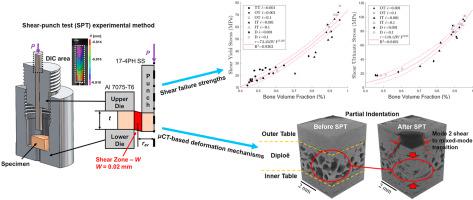Journal of the Mechanical Behavior of Biomedical Materials ( IF 3.3 ) Pub Date : 2021-01-22 , DOI: 10.1016/j.jmbbm.2021.104343 A.D. Brown , K.A. Rafaels , T. Weerasooriya

|
A shear-punch test (SPT) experimental method was developed to address the lack of shear deformation and failure response data for the human skull as a function of local bone microarchitecture. Improved understanding of skull deformation and fracture under varying stress-states helps implement mechanism-based, multi-axial material models for finite element analysis for optimizing protection strategies. Shear-punch coupons (N = 47 specimens) were extracted from right-parietal and frontal bones of three fresh-frozen-thawed human skulls. The specimens were kept as full through-thickness or segmented into the three skull constituent layers: the inner and outer cortical tables and the middle porous diploë. Micro-computed x-ray tomography (μCT) before and after SPT provided the bone volume fraction (BVF) as a function of depth for correlation to shear mechanisms in the punched volumes. Digital image correlation was used to track displacement of the punch above the upper die to minimize compliance error. Five full-thickness specimens were subjected to partial indentation loading to investigate the process of damage development as a function of BVF and depth. It was determined that BVF dominates the shear yield and ultimate strength of human skull bone, but the imposed uniaxial loading rate (0.001 and 0.1 s−1) did not have as strong a contribution (p = 0.181–0.806 > 0.05) for the shear yield and ultimate strength of the skull bone layer specimens. Shear yield and ultimate strength data were highly correlated to power law relationships of BVF (R2 = 0.917–0.949). Full-thickness and partial loaded SPT experiments indicate the diploë primarily dictates the shear strength of the intact structure.
中文翻译:

人类颅骨的剪切行为
开发了一种剪切冲击试验(SPT)实验方法来解决由于局部骨骼微体系结构而导致的人体头骨剪切变形和失效响应数据不足的问题。更好地了解在不同应力状态下的颅骨变形和骨折,有助于实施基于机制的多轴材料模型以进行有限元分析,从而优化保护策略。从三个新鲜冻融的人头骨的右顶骨和额骨中提取了剪切冲孔试样(N = 47个样本)。标本应保持完整的厚度,或分成三个颅骨组成层:内,外皮层表和中层多孔双壁。SPT之前和之后的微计算机X射线断层扫描(μCT)提供了作为深度函数的骨体积分数(BVF),以与打孔体积中的剪切机制相关。数字图像相关性用于跟踪上模上方冲头的位移,以最大程度地降低柔顺度误差。对五个全厚度试样进行部分压痕加载,以研究损伤发展与BVF和深度的关系。已确定BVF支配着人类颅骨的剪切屈服强度和极限强度,但是强加于单轴加载速率(0.001和0.1 s 对五个全厚度试样进行部分压痕加载,以研究损伤发展与BVF和深度的关系。已确定BVF支配着人类颅骨的剪切屈服强度和极限强度,但是强加于单轴加载速率(0.001和0.1 s 对五个全厚度试样进行部分压痕加载,以研究损伤发展与BVF和深度的关系。已确定BVF支配着人类颅骨的剪切屈服强度和极限强度,但是强加于单轴加载速率(0.001和0.1 s-1) 对头骨层标本的剪切屈服强度和极限强度没有很大的贡献(p = 0.181–0.806> 0.05)。剪切屈服强度和极限强度数据与BVF的幂律关系高度相关(R 2 = 0.917–0.949)。全厚度和部分加载的SPT实验表明,双曲线主要决定了完整结构的抗剪强度。











































 京公网安备 11010802027423号
京公网安备 11010802027423号